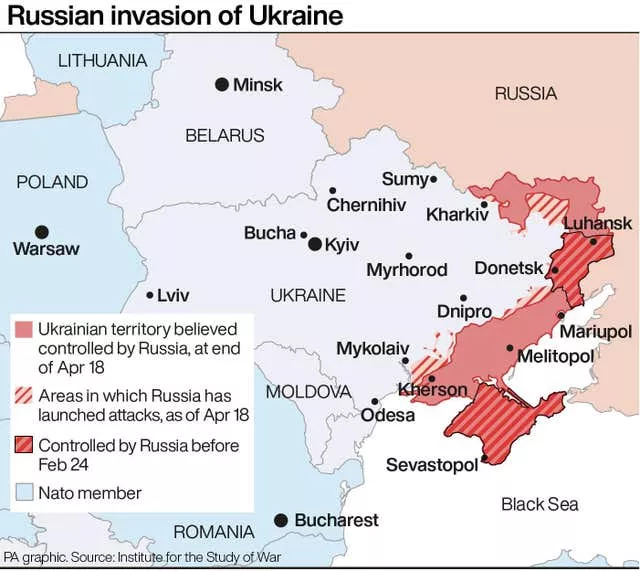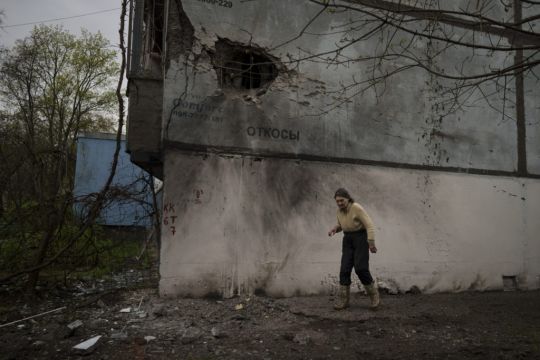Russia assaulted cities and towns along a boomerang-shaped front hundreds of miles long and poured more troops into Ukraine on Tuesday, in a potentially pivotal battle for control of the country’s eastern industrial heartland of coal mines and factories.
If successful, the Russian offensive in what is known as the Donbas would essentially slice Ukraine in two and give Russian president Vladimir Putin a badly needed victory after the failed attempt by Moscow’s forces to storm the capital, Kyiv, and heavier-than-expected casualties nearly two months into the war.
The cities of Kharkiv and Kramatorsk came under deadly attack, and Russia also said it struck areas around Zaporizhzhia and Dnipro west of the Donbas with missiles.

Russian defence ministry spokesman Igor Konashenkov said air-launched missiles destroyed 13 Ukrainian troop and weapons locations, while the air force struck 60 other Ukrainian military facilities, including missile warhead storage depots.
Russian artillery hit nearly 1,300 Ukrainian military facilities and more than 1,200 troop concentrations over the past 24 hours, he said. The claims could not be independently verified.
In what both sides described as a new phase of the war, the Russian assault began on Monday along a front stretching more than 300 miles from north-eastern Ukraine to the country’s south east.
Ukraine’s military said Russian forces tried to “break through our defences along nearly the entire front line”.
Weeks ago, after the abortive Russian push to take Kyiv, the Kremlin declared that its main goal was the capture of the mostly Russian-speaking Donbas, where Moscow-backed separatists have been fighting Ukrainian forces for eight years.

A Russian victory in the Donbas would deprive Ukraine of the industrial assets concentrated there, including mines, metals plants and heavy-equipment factories.
A senior US defence official said the Russians had added two more combat units, known as battalion tactical groups, in Ukraine over the preceding 24 hours.
That brought the total number of units in the country to 78, all of them in the south and the east, up from 65 last week, the official said.
That would translate to about 55,000 to 62,000 troops, based on what the Pentagon said at the start of the war was the typical unit strength of 700 to 800 soldiers.
A European official said Russia also has 10,000 to 20,000 foreign fighters in the Donbas. They are a mix of mercenaries from Russia’s private Wagner Group and Russian proxy fighters from Syria and Libya, according to the official.
While Ukraine portrayed the attacks on Monday as the start of the long-feared offensive in the east, some observers noted that an escalation has been under way there for some time and questioned whether this was truly the start of a new offensive.

The US official said that the offensive in the Donbas has begun in a limited way, mainly in an area southwest of the city of Donetsk and south of Izyum.
European and US arms have played a key role in enabling the outgunned Ukrainians to hold off the Russians.
The Dutch prime minister told Ukrainian president Volodymyr Zelensky on Tuesday that the Netherlands would send “heavier material,” including armoured vehicles.
Associated Press journalists in Kharkiv said at least four people were killed and three wounded in a Russian attack on a residential area of the city.
The attack happened as residents attempted to maintain a sense of normaity, with council workers planting spring flowers in public areas.
An explosion also rocked Kramatorsk, killing at least one person and wounding three, according to AP journalists at the scene.

Military experts said the Russians’ goal is to encircle Ukrainian troops from the north, south and east.
Key to the campaign is the capture of Mariupol, the now-devastated city in the Donbas that the Russians have besieged since the early days of the war.
Taking Mariupol would deprive Ukraine of a vital port and complete a land bridge between Russia and the Crimean Peninsula, seized from Ukraine from 2014.
It would also free up Russian troops to move elsewhere in the Donbas.
A few thousand Ukrainian troops, by the Russians’ estimate, remained holed up in a sprawling Mariupol steel plant, representing what was believed to be the last major pocket of resistance in the city.
On Tuesday, Russia issued a new ultimatum to the Ukrainian defenders to surrender, saying those who come out will “keep their lives,” and said a ceasefire was being declared in the area so the combatants could leave the plant.
The Ukrainians have ignored previous such offers, and there was no immediate confirmation a ceasefire occurred.







